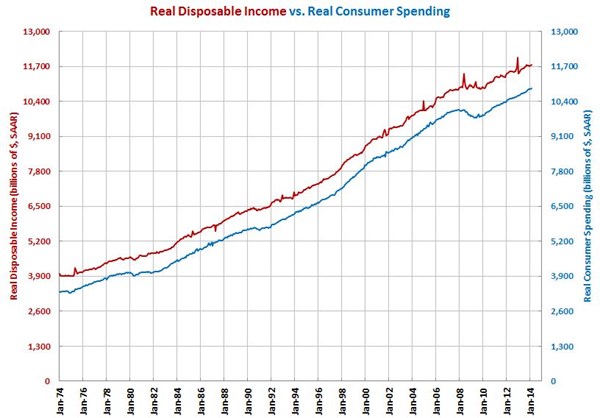Consumer Spending Growth Slows to 2.1%
Real consumer spending has grown faster than 2.0% for the last five months. However, the rate of growth has decelerated each of the last three months.
According to the Bureau of Economic Analysis, real consumer spending in February 2014 was $10,871 billion real dollars (seasonally adjusted at an annual rate). This is an all-time high for consumer spending, but it is the first new record high in three months. Spending in February 2014 was 2.1% more than it was in February 2013. Real consumer spending has grown faster than 2.0% for the last five months. However, the rate of growth has decelerated each of the last three months.
The annual rate of growth inched up to 2.1% after sitting at 2.0% the last four months. This is the fastest rate of annual growth in consumer spending since May 2013. However, the annual rate of growth has been essentially flat since the summer of 2012. The historical average annual rate of growth is 3.3%. So, spending growth is still running quite a bit below normal. In the next month or two, the annual rate of change in spending may move a few ticks higher. But, with annual growth in incomes still in decelerating growth trend that started in late 1998, it is unlikely that real consumer spending will see a significant acceleration in its rate of growth.
Real durable goods spending is growing at virtually its slowest rate since it stopped contracting as a result of the financial crisis in 2009.The month-over-month rate of change has decelerated from 8.9% in August 2013 to 2.7% in February 2014. As a result, the annual rate of change has decelerated to its slowest rate of growth since May 2012.
Real consumer spending (or its sub-components such as medical care spending) is an important leading for a number of durable goods end markets: construction materials; custom processors; durable goods; food and beverage processing; forming and fabricating (non-auto); hardware; HVAC; industrial motors, hydraulics and mechanical components; machinery and equipment manufacturing; medical; metalcutting job shops; oil, gas field and mining machinery; power generation; primary metals; and printing.
Most of these subcategories of spending have been growing slower or contracting faster in recent months. The one notable exception is real medicare spending, which grew at its fastest monthly rate since October 2002. The monthly rate of growth in medical care spending has accelerated for five straight months. The rapid increase in medical care spending due to Obamacare seems to be dampening spending in most almost every other area.




.JPG;width=70;height=70;mode=crop)